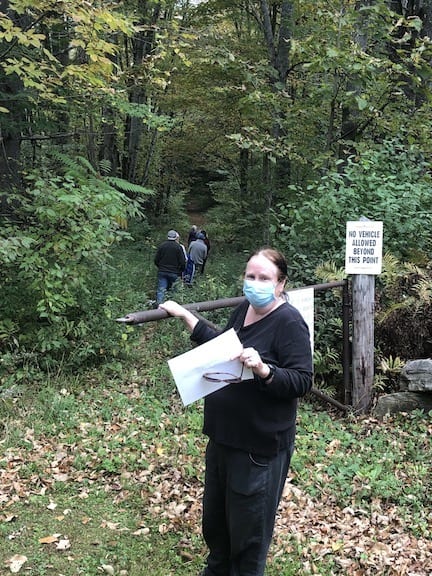
CAVENDISH, Vt. – For such a small town, less than 40 square miles and a population coming in around 1,500, Cavendish has a rich history, kept alive thanks in large part to a vibrant Cavendish Historical Society led by President Margo Caulfield.
She’s not only the local expert on Phineas Gage and Aleksandr Solzhenitsyn, some of Cavendish’s more well-known historical figures, but continues to keep Fittonsville and “Firebug” Fitton alive for residents and school children in Cavendish.
Caulfield led a recent walking tour Sunday, Oct. 3 for over a dozen history buffs, to a now-overgrown and little-known section of Cavendish once known as Fittonsville, former home of a complex of buildings that surrounded the Spring Mill, including a storehouse, boarding house, tenements, and other smaller outbuildings.
The Spring Mill, locally referred to as Fittons Mill, was a woolen mill built along the Black River in 1867, but better known for being burned down in 1875 by its notorious owner Robert “Firebug” Fitton. Fitton later burned down the mill’s storehouse in February of 1877, and the boarding house in June 1878 as well as a handful of other mills and buildings in the area, over the span of a decade or more, including what is now the Cavendish Historical Society Museum.
Though Fittonsville was once a vibrant working and living area for over 100 employees, all that remains are stone foundations hidden among the trees near the Black River, below the current roadway.
The tour started at the Historical Society Museum building and meandered around the corner toward what was once the train depot. Workers for the mill would have been dropped off there, though the stone steps leading up to the old platform had long sat unused. The tour walked the same short distance workers would have followed on the way to the mill. Instead of staying on the road that exists now, the group walked down a sloping dirt road on the left that leads down to the Black River. From there they passed through a modern metal gate that led to a hydro dam maintained by Green Mountain Power. There they walked on what was once a cobblestone lane that traveled through Fittonsville, connecting the mill to storehouse, boardinghouse, tenements, and other small outbuildings. The schoolhouse, which was situated on the main road above, is the only surviving Fittonsville structure and has seen numerous renovations as a single-family home.
The rest is gone, or rather, hidden. The cobblestones from the lane have long since been repurposed or buried. Once surrounded by cleared fields and leading through the structures of Fittonsville, those features are now overwhelmed and overshadowed by trees. Looking carefully, remnants of stone culverts, retaining walls, and stone foundations help clarify the footprints of buildings where they once stood. Moss covered bricks, left over from hearths and chimneys, are scattered amongst the roots, and wooded, rocky landscape.
Down near the Black River, several submerged walls showed where the mill’s water wheel once hovered in the river, generating power as the water rushed by. An interesting discovery for anyone on this tour is the remains of a 1920s car, which floated down the river during the devasting 1927 flood and lodged within the mill’s submerged stonewalls. Though the car remained in one piece for decades, in recent years the relic has broken apart and now sits in several crevasses in the general area.
As the walking tour navigated some of the rugged terrain off the main path, Caulfield peppered the walk by pointing out sections of the mill or other buildings and shared how the loss of the mill devastated the town and threw the woolen industry into chaos. She also shared details about Fitton himself, who spent 12 years in jail for arson as well as perjury and fraud.
“It amazes me to think how much was here and how industrialized it all was,” she said.
Back at the CHSM building, additional pictures of the mill, both before and after the fire, and various newspaper articles helped complete the full picture of what had been lost – that is, until the Cavendish Historical Society and Caulfield helped visitors find it again.